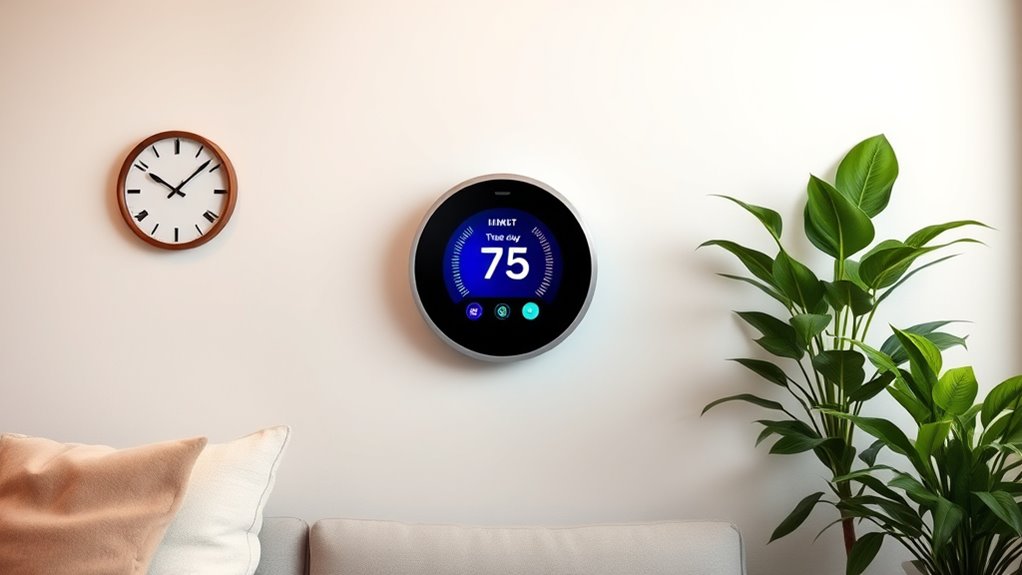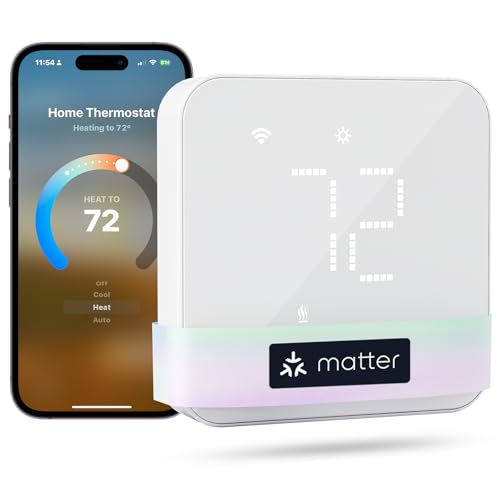If you want a smarter home, I recommend exploring the best learning thermostats like the Google Nest (3rd and 4th Gen), ecobee Smart Thermostat Premium, and budget-friendly options like the Nest Thermostat E and Sensi. These models adapt to your routines, help save energy, and integrate with your smart home ecosystem. Want to discover which one fits your needs best? Keep going, and I’ll guide you through the top choices and features.
Key Takeaways
- The top smart thermostats feature advanced learning capabilities like Auto-Schedule and routine adaptation to optimize home comfort.
- Compatibility with popular voice assistants (Alexa, Google Assistant, Apple HomeKit) enhances seamless smart home integration.
- Many models offer energy-saving functions, reducing heating and cooling costs through personalized scheduling and sensors.
- Easy installation and user-friendly interfaces make setup accessible for DIY homeowners and professional installers alike.
- Certifications like ENERGY STAR ensure efficient operation and potential long-term savings on energy bills.
Google Nest Learning Thermostat, 3rd Gen
If you’re looking for a smart thermostat that combines sleek design with intelligent energy-saving features, the Google Nest Learning Thermostat, 3rd Gen, is an excellent choice. Its modern, rounded design with a bright 2.08-inch display fits seamlessly into any home. It learns your schedule through Auto-Schedule, reducing manual programming, and uses Home/Away Assist to save energy when you’re not home. You can control it remotely via the Nest app or with voice commands through Alexa or Google Assistant. Certified ENERGY STAR, it helps lower utility bills—often saving users around 10-12% on heating and cooling costs.
Best For: homeowners seeking a sleek, energy-efficient smart thermostat that offers easy remote control and voice integration.
Pros:
- Modern, stylish round design with a bright 2.08-inch display that fits seamlessly into various home décors
- Learns user schedules with Auto-Schedule and uses Home/Away Assist to optimize energy savings automatically
- Compatible with Alexa and Google Assistant for convenient voice control and remote management through the Nest app
Cons:
- Installation may require basic wiring knowledge; complex HVAC systems might need professional setup
- Results in energy savings can vary depending on individual usage and system compatibility
- Limited diagnostic information; provides notifications but not detailed troubleshooting guidance
Google Nest Learning Thermostat (4th Gen, 2024)
The Google Nest Learning Thermostat (4th Gen, 2024) stands out as an ideal choice for homeowners seeking a stylish, highly intelligent thermostat that seamlessly integrates with their smart home systems. Its sleek design features a polished silver finish, a larger display, and Dynamic Farsight for easy viewing from across the room. It works with most 24V systems, often without needing a C wire, and installs quickly—often self-serve. Compatible with Alexa, Google Assistant, Apple HomeKit, and Matter, it offers auto-scheduling, voice control, and room-specific temperature control via sensors. Users experience energy savings and a modern aesthetic, making it a smart, efficient upgrade for any home.
Best For: homeowners seeking a sleek, energy-efficient smart thermostat that easily integrates with existing smart home ecosystems and offers advanced features for personalized comfort.
Pros:
- Stylish, modern design with a large, easy-to-read display and Dynamic Farsight.
- Compatible with most 24V systems and supports multiple smart home platforms including Alexa, Google Assistant, Apple HomeKit, and Matter.
- Features auto-scheduling, learning routines, and room-specific control via sensors, leading to significant energy savings.
Cons:
- Higher price point compared to previous models, which may be a consideration for budget-conscious buyers.
- Limited compatibility outside the US, with some users in the UK rating it slightly lower.
- Installation may still require some technical knowledge, despite being designed for self-serve setup.
ecobee Smart Thermostat Premium with Sensors and Air Quality Monitor
The ecobee Smart Thermostat Premium stands out as a top choice for homeowners seeking energy savings and advanced home monitoring. It can cut heating and cooling costs by up to 26% annually and features SmartSensors that eliminate hot and cold spots, improving comfort and efficiency. The thermostat detects open windows or doors, automatically pausing HVAC to save energy. It also monitors air quality, alerting you to poor conditions and reminding you to change filters. With built-in smoke detection, security alerts, and compatibility with major smart home platforms, it offers a exhaustive, user-friendly experience. Its sleek design and easy installation make it a smart upgrade for any modern home.
Best For: homeowners seeking to maximize energy efficiency, enhance home comfort, and incorporate advanced smart home monitoring and security features.
Pros:
- Helps reduce heating and cooling costs by up to 26% annually with ENERGY STAR certification
- Advanced sensors eliminate hot and cold spots, improving comfort and efficiency
- Built-in air quality monitor and security alerts promote a healthier and safer home environment
Cons:
- Regional restrictions may limit location-based features and sensor functionality
- Requires Apple Home Hub for Siri compatibility, adding extra setup for Apple users
- Some users find the initial setup and sensor placement challenging without proper instructions
Google Nest Thermostat, Programmable Wi-Fi Smart Thermostat
Rated highly for its energy-saving features and sleek design, the Google Nest Thermostat stands out as an excellent choice for homeowners seeking a smart, programmable Wi-Fi thermostat. It’s ENERGY STAR certified, helping you cut energy costs, and allows remote control through the Google Home app on Android and iPhone. The device’s modern LCD display, backlight, and easy wall-mount design make installation simple—usually within 30 minutes. It supports voice commands via Google Assistant and Alexa, adapts to your schedule, and detects system issues with alerts. Overall, it combines style, convenience, and efficiency, making it a top pick for smarter home climate control.
Best For: homeowners seeking an easy-to-install, energy-efficient smart thermostat with remote control and voice command capabilities.
Pros:
- ENERGY STAR certified, promoting energy savings and lower utility bills
- Supports remote control via Google Home app on Android and iPhone for convenience
- Modern design with a clear LCD display and simple wall-mount installation
Cons:
- May require a C wire or power accessory for certain HVAC systems, complicating installation
- Dependence on Wi-Fi and internet connection can lead to operational issues during outages
- Initial setup can be challenging for some users, especially with wiring or compatibility concerns
ecobee Smart Thermostat Essential – Wi-Fi Programmable Thermostat
If you’re looking to maximize energy savings without sacrificing comfort, the ecobee Smart Thermostat Essential is an excellent choice. It can save you up to 23% annually on heating and cooling costs by automatically adjusting to your schedule, conserving energy when you’re away, and enhancing comfort when you’re home. You can track your energy use remotely via the ecobee app, and regular software updates keep it running smoothly with new features. It supports most HVAC systems, including heat pumps and boilers, and is easy to install with or without a C-wire. Plus, it integrates seamlessly with smart home platforms like Alexa, Google Assistant, and Apple HomeKit.
Best For: homeowners seeking to enhance energy efficiency and comfort with a user-friendly, Wi-Fi-enabled smart thermostat compatible with most HVAC systems.
Pros:
- Saves up to 23% annually on heating and cooling costs.
- Easy DIY installation, no C-wire needed with optional PEK.
- Compatible with leading smart home platforms like Alexa, Google Assistant, and Apple HomeKit.
Cons:
- Compatibility with HVAC systems should be verified via ecobee online checker.
- No built-in voice control; relies on smart home integrations.
- Limited to Wi-Fi connectivity, which may require a stable internet connection for optimal performance.
Amazon Smart Thermostat
Looking to upgrade your home heating and cooling system effortlessly? The Amazon Smart Thermostat makes it simple, especially if you’re already using Alexa or Ring devices. It requires a C-wire for installation but is built with Honeywell’s trusted technology, ensuring reliability. With ENERGY STAR certification, it can save you about $50 annually on energy bills by automatically adjusting temperature based on presence or readings. You can control it remotely via the Alexa app or just ask Alexa to change the temperature. Plus, installation is straightforward with the app’s guidance, and Amazon offers support and rebate info to maximize your savings and comfort.
Best For: homeowners seeking an easy, reliable upgrade to energy-efficient smart thermostats compatible with Alexa and Ring devices.
Pros:
- Easy installation guided by the Alexa app, with customer support available.
- Compatible with Alexa and Ring for seamless remote and voice control.
- ENERGY STAR certified, helping save approximately $50 annually on energy bills.
Cons:
- Requires a C-wire for installation, which may not be present in all homes.
- Limited to homes with existing smart home ecosystems like Alexa or Ring.
- Dependence on Wi-Fi connectivity for remote control and automation features.
ecobee Smart Thermostat Enhanced, Programmable WiFi Thermostat
The ecobee Smart Thermostat Enhanced stands out for homeowners seeking effortless energy savings and personalized comfort. It can save up to 26% annually on heating and cooling costs by automatically adjusting the temperature when you’re away and preheating or precooling your home before arrival. The thermostat also manages humidity levels for consistent comfort day and night. Installation is straightforward, especially with the Power Extender Kit for homes without a C-wire, and it’s compatible with most 24 VAC HVAC systems. Plus, you can control it remotely via smartphone, tablet, or Apple Watch, and it works seamlessly with voice assistants like Alexa, Siri, and Google.
Best For: homeowners seeking an easy-to-install, energy-efficient thermostat that offers remote control and smart home compatibility for personalized comfort and savings.
Pros:
- Saves up to 26% annually on heating and cooling costs through automatic adjustments and scheduling
- Easy installation with Power Extender Kit and compatibility with most 24 VAC HVAC systems
- Supports smart home voice assistants like Alexa, Siri, and Google, and integrates with smart sensors for room-specific comfort
Cons:
- Requires WiFi connection for remote control and smart features
- May not be compatible with non-24 VAC HVAC systems or older, unconventional systems
- Some users might find initial setup or app navigation challenging without prior smart device experience
Google Nest Learning Thermostat, 3rd Gen
The Google Nest Learning Thermostat (3rd Gen) stands out for anyone seeking a truly smart and adaptive climate control system. It learns your schedule and preferred temperatures, automatically adjusting to optimize comfort and save energy. The Nest Leaf highlights energy-efficient choices, encouraging smarter usage. You can review your energy history and system performance via your phone or the device display. It monitors HVAC health, sends alerts, and offers maintenance reminders. With Home/Away Assist, it adjusts to Eco Temperature when you’re gone. Plus, remote control from any device and compatibility with Alexa make managing your home’s temperature effortless and efficient.
Best For: those seeking an intelligent, adaptive, and energy-efficient thermostat that seamlessly integrates with smart home ecosystems and offers remote control capabilities.
Pros:
- Learns user schedules and preferences for automatic, personalized temperature adjustments
- Monitors HVAC system health, providing alerts and maintenance reminders to enhance efficiency
- Compatible with Alexa and supports additional sensors for precise room temperature control
Cons:
- Requires Wi-Fi connectivity for remote features and updates
- May involve additional cost for compatible sensors and installation services
- Learning curve for users unfamiliar with smart thermostats or home automation systems
Google Nest Learning Thermostat, 3rd Generation
If you’re seeking a sleek, self-learning thermostat that adapts to your schedule and energy habits, the Google Nest Learning Thermostat (3rd Generation) is an excellent choice. Its modern, round design features a larger, sharper LCD display with Far Sight technology that lights up when you’re nearby, showing time or temperature from across the room. It supports auto-schedule and energy-saving modes, and works with Wi-Fi, app control, and voice assistants like Alexa and Google Assistant. Installation is straightforward for most systems, though some wiring setups may need extra transformers. Overall, it combines style, functionality, and smart features to help you manage your home’s climate efficiently.
Best For: homeowners and DIY enthusiasts seeking a stylish, self-learning smart thermostat with easy app and voice control integration.
Pros:
- Sleek, modern design with a larger, sharp LCD display and Far Sight technology
- Supports auto-schedule, energy-saving features, and voice control via Alexa and Google Assistant
- Easy to install for most systems, with included mounting hardware and remote app management
Cons:
- Setup can be challenging for users unfamiliar with wiring configurations or smart thermostats
- Requires additional transformers if a C wire is absent, potentially complicating installation
- Mixed customer reviews on software updates, connectivity, and long-term reliability
Google Nest Thermostat E, 3rd Gen Programmable Smart Thermostat
For homeowners seeking an affordable yet effective smart thermostat, the Google Nest Thermostat E, 3rd Gen offers a sleek design combined with advanced energy-saving features. Its minimalist frosted display blends seamlessly into any decor, and it’s easy to control via app or voice. The thermostat learns your preferences to create personalized schedules, helping you save on energy bills. It supports auto-scheduling, HVAC monitoring, and works with popular smart home platforms like Alexa and Google Assistant. Installation is straightforward, and most users find it user-friendly. While some experience minor voice command issues and support challenges, overall, it’s a durable, stylish, and budget-friendly choice for smart home automation.
Best For: homeowners looking for an affordable, stylish, and easy-to-use smart thermostat that offers energy savings and simple integration with popular smart home platforms.
Pros:
- Sleek, minimalist design that blends seamlessly into home decor
- Easy installation and user-friendly controls via app and voice commands
- Supports energy-saving features like auto-scheduling, HVAC monitoring, and remote control
Cons:
- Some users experience minor issues with voice command integration, particularly with Alexa
- Customer support and warranty service can be inconsistent or challenging to access
- May require professional installation if wiring is complex or on older systems
RTH9585WF1004 Wi-Fi Smart Color Thermostat
The RTH9585WF1004 Wi-Fi Smart Color Thermostat stands out for its vibrant, customizable display, making it an excellent choice for anyone who wants to blend smart home convenience with personalized decor. Its bright touchscreen is easy to read and operate, while customizable colors let you match your thermostat to your interior. With flexible scheduling and compatibility with various heating systems, it adapts to your needs. ENERGY STAR certified, it helps save energy and offers monthly reports and personalized tips. Plus, it supports Alexa and other smart home integrations, and participating in utility programs can earn you rebates and rewards.
Best For: homeowners seeking a customizable, energy-efficient smart thermostat with vibrant display and smart home integration.
Pros:
- Bright, easy-to-read touchscreen with customizable color options for personalized decor
- Compatible with a wide range of heating systems including gas, oil, electric, and heat pumps with electric backup
- ENERGY STAR certified, offering energy savings, monthly reports, and personalized efficiency tips
Cons:
- Not compatible with electric baseboard heat (120-240V)
- C-Wire required; may need a power adapter if not available
- Limited compatibility with certain heating systems like electric baseboard heat
RTH9600WF Smart Color Thermostat
The RTH9600WF Smart Color Thermostat stands out for homeowners who want both advanced features and customizable aesthetics. Its high-definition color touchscreen display can be personalized to match your decor, adding a sleek look to any room. This ENERGY STAR certified device offers Wi-Fi control via the Honeywell app and supports voice commands through Alexa, Google Assistant, and others. With Honeywell’s Smart Response technology, it learns your home’s cycle times for efficient heating and cooling. Compatible with various HVAC systems, it requires a C-wire for power, ensuring reliable operation. Overall, it combines smart functionality with visual flexibility for a truly customizable experience.
Best For: homeowners seeking a customizable, energy-efficient smart thermostat with advanced Wi-Fi control and aesthetic flexibility.
Pros:
- High-definition color touchscreen display customizable to any decor style
- Supports voice control with Alexa, Google Assistant, and more for hands-free operation
- ENERGY STAR certified, promoting energy savings and environmental benefits
Cons:
- Requires a C-wire for power, which may complicate installation for some users
- App updates have lacked innovation since 2014, limiting new features
- Humidity control and background display options can be less intuitive or limited
meross Smart Thermostat for Home
If you’re seeking a budget-friendly yet reliable smart thermostat, the meross Smart Thermostat (Model MTS300) is an excellent choice. It supports most HVAC systems, including conventional heating, cooling, and heat pumps, but not electric baseboard heaters. Installation is straightforward with proper wiring and setup through the Meross app. It offers 7×24-hour scheduling, remote control, and voice compatibility with Alexa, Apple HomeKit, Google Assistant, and Samsung SmartThings. Designed for energy efficiency, it provides usage data to help save on bills. With a sleek design and high ratings, it’s a solid, affordable upgrade for smarter home climate control.
Best For: homeowners seeking an affordable, reliable smart thermostat compatible with most HVAC systems and easy to install and operate.
Pros:
- Supports a wide range of HVAC systems including heat pumps and conventional setups
- Easy installation with straightforward setup via the Meross app
- Offers comprehensive scheduling, remote control, and voice compatibility with popular assistants
Cons:
- Not compatible with electric baseboard heaters
- Requires a C-wire for proper operation, which may necessitate additional adapters for some homes
- Limited to 2.4GHz Wi-Fi networks, potentially affecting connectivity in some environments
Sensi Lite Smart Thermostat
For anyone seeking an easy-to-install, budget-friendly smart thermostat, the Sensi Lite stands out as an excellent choice. It’s designed for straightforward DIY setup with built-in leveling and step-by-step instructions, making installation hassle-free. Compatible with most HVAC systems and Wi-Fi, it works seamlessly with Alexa and is ENERGY STAR certified, helping you save about 23% on energy costs. You can control it remotely via a user-friendly mobile app, giving you flexibility and convenience. Most systems don’t need a C-wire, simplifying installation even further. Overall, the Sensi Lite offers reliable performance, energy savings, and easy control at an affordable price.
Best For: DIY homeowners seeking an affordable, easy-to-install smart thermostat compatible with most HVAC systems and Wi-Fi.
Pros:
- Easy DIY installation with built-in level and step-by-step instructions
- Compatible with Alexa, Wi-Fi, and energy-efficient, ENERGY STAR certified
- No C-wire required for most systems, simplifying setup
Cons:
- May not be suitable for heat/cool only or heat pump systems that require a C-wire
- Lacks advanced features found in higher-end smart thermostats
- Remote access depends on a stable Wi-Fi connection
Sensi Smart Thermostat
Among the top smart thermostats, the Sensi Smart Thermostat stands out for homeowners seeking an easy-to-install, energy-saving solution that doesn’t require a C-wire. Its Wi-Fi connectivity, programmable controls, and compatibility with most HVAC systems make it versatile. I appreciate its sleek design, LED display, and simple manual controls. Setup is straightforward, with step-by-step app guidance, often eliminating the need for a C-wire. Sensi helps reduce energy consumption by around 23%, monitors system performance, and provides maintenance alerts. Its compatibility with Alexa, Google Assistant, and other platforms allows for voice control and remote management, making it an excellent choice for a hassle-free upgrade.
Best For: homeowners seeking an easy-to-install, energy-efficient smart thermostat that works without a C-wire and offers seamless integration with voice assistants.
Pros:
- Simple DIY installation with step-by-step app guidance and no C-wire needed in most cases
- Energy savings of approximately 23% through flexible scheduling and remote management
- Compatible with popular voice platforms like Alexa and Google Assistant for hands-free control
Cons:
- Some users experience delays of 20-25 seconds between setting adjustments and HVAC response
- Limited detailed usage data, such as specific run times and breakdowns
- No support for Bixby or more advanced smart home integrations
Factors to Consider When Choosing Smart Thermostats With Learning Features

When choosing a smart thermostat with learning features, I consider how well it works with my HVAC system and how easy it is to install. I also look at the accuracy of its learning algorithms and how seamlessly it integrates with my existing smart home devices. Finally, I weigh its potential for energy savings to guarantee it’s a smart investment.
Compatibility With HVAC Systems
Choosing a smart thermostat with learning features requires guaranteeing it’s compatible with your HVAC system. First, verify that it supports your system type—gas, electric, oil, heat pump, or boiler—to ensure ideal performance. Check if your system needs a C-wire or if the thermostat can operate without one, possibly using power extender kits or alternative wiring solutions. It’s also important to confirm compatibility with your system’s voltage and control signals to avoid installation issues. Additionally, make sure the thermostat’s auto-scheduling and learning features are designed to work seamlessly with your system’s control architecture. Finally, review manufacturer compatibility lists or online checkers to confirm your system is supported before making a purchase, preventing any compatibility surprises later on.
Ease of Installation
Installing a smart thermostat with learning features can be straightforward if you consider a few key factors. Many models now support DIY installation with clear step-by-step guides, making setup accessible for most homeowners. Compatibility with your existing HVAC wiring is essential—especially the presence of a C-wire, which simplifies power supply. If your home lacks a C-wire, some thermostats include power extender kits or can operate without one, easing installation in older wiring systems. Clear wiring diagrams, app-based setup instructions, and pre-labeled wires can greatly reduce installation time and errors. Overall, choosing a thermostat with an intuitive setup process leads to higher satisfaction and faster installation, ensuring you can enjoy your smart home upgrade without hassle.
Learning Algorithm Accuracy
The accuracy of a smart thermostat’s learning algorithm plays a essential role in delivering consistent comfort and maximizing energy savings. An accurate algorithm learns your routines over time, reducing manual adjustments and ensuring your home stays comfortable. Its precision directly impacts how well it manages climate control and efficiency, with better algorithms providing more reliable results. Frequent use and consistent routines help improve learning accuracy by generating more data points. Some thermostats enhance their algorithms with sensors and contextual data like occupancy detection and weather conditions, which boost adaptability. The effectiveness of these algorithms can be judged by how swiftly and reliably they adjust to changing preferences or environmental factors. Ultimately, choosing a thermostat with a proven, accurate learning algorithm means better comfort and greater energy savings.
Integration With Smart Home
When selecting a smart thermostat with learning features, it’s vital to take into account how well it integrates with your existing smart home ecosystem. Compatibility with popular platforms like Alexa, Google Assistant, Apple HomeKit, and SmartThings ensures smooth voice control and automation. Support for protocols such as Matter improves interoperability across various devices, making setup easier and more reliable. Integration with other smart devices, like sensors and security systems, allows for coordinated automation that can adapt to your daily routines. Compatibility with smart home hubs and automation platforms enables you to create scenes, schedules, and remotely manage your thermostat seamlessly. Ultimately, strong integration offers a unified experience, making your smart home more intuitive, efficient, and easier to control.
Energy Savings Potential
Smart thermostats with learning features have the potential to considerably cut energy costs by automatically adjusting heating and cooling based on your habits. On average, they save users about 10-15% annually on energy bills. These devices analyze your routines and make adjustments, reducing unnecessary HVAC operation. Features like occupancy sensors and auto-schedule functions further boost efficiency by minimizing heating or cooling when no one’s home. Energy history reports and usage tracking help you identify patterns, so you can optimize settings for maximum savings. Additionally, many models are compatible with utility rebate programs and demand response incentives, which can lead to extra savings. Overall, choosing a smart thermostat with robust learning capabilities can notably reduce energy waste and lower your utility bills over time.
Price and Value
Choosing a smart thermostat with learning features requires balancing price and value to get the most benefit for your money. Prices range from around $50 for basic models to over $250 for premium options, impacting long-term savings and features. Higher-priced thermostats often offer advanced capabilities like multi-room sensors, air quality monitoring, and voice assistant integration, which can enhance comfort and efficiency. Investing a bit more upfront in a model with strong energy-saving features can quickly pay off through reduced utility bills, often within a year or two. Compatibility with your existing HVAC system and smart home setup is also vital to avoid costly upgrades later. Additionally, considering warranty, customer support, and software updates helps guarantee you’re choosing a device that offers good overall value beyond just the initial price.
Frequently Asked Questions
How Do Learning Thermostats Impact Energy Savings Long-Term?
Learning thermostats substantially boost my long-term energy savings by adapting to my schedule and preferences. They automatically optimize heating and cooling, preventing energy waste when I’m away or asleep. Over time, I notice lower utility bills because these devices fine-tune their settings based on my habits. I love how they make my home more efficient without me constantly adjusting the temperature, saving money and reducing my environmental impact.
Are Smart Thermostats Compatible With All HVAC Systems?
Most smart thermostats are compatible with standard HVAC systems, but about 20% of older or specialized setups need additional wiring or adapters. I’ve found that checking your system’s compatibility beforehand saves a lot of hassle. I recommend consulting the thermostat’s compatibility guide or a professional installer. That way, you guarantee seamless integration and maximize your smart home’s efficiency without surprises.
Can These Thermostats Be Controlled Manually During Power Outages?
During power outages, most smart thermostats can’t be controlled remotely or manually via their usual apps or interfaces. However, many models have manual controls on the device itself, allowing you to adjust the temperature directly. Keep in mind, these manual controls might be limited and may not function if power is completely out. To make certain of continuous control, consider installing a backup power source or a traditional thermostat as a backup.
Do Learning Features Adapt to Seasonal Climate Changes Automatically?
Yes, most learning thermostats adapt automatically to seasonal climate changes. I’ve seen them analyze your heating and cooling patterns over time, adjusting settings to match the changing weather outside. It’s like having a home that learns your preferences and the environment without you doing anything. This seamless adaptation keeps your home comfortable year-round, making smart living smarter and easier. Isn’t that the kind of comfort we all want?
How Secure Is the Wi-Fi Connection for Smart Thermostat Data?
Your Wi-Fi connection for a smart thermostat is generally secure, but it depends on your setup. I recommend using a strong, unique password and enabling WPA3 encryption if possible. Keeping your firmware updated is essential, as manufacturers patch security vulnerabilities regularly. Avoid default passwords and connect the device to a separate network if you’re really concerned. These steps help protect your data and prevent unauthorized access to your smart home.
Conclusion
So, after all this, it turns out picking a smart thermostat is pretty straightforward—just find one that learns your habits, and you’ll never have to think about temperature again. Ironically, the hardest part is choosing which “smart” feature to obsess over. But don’t worry, no matter which you pick, you’re basically outsourcing your comfort to a device that’s smarter than you. Now, that’s progress, or maybe just laziness in disguise.


























